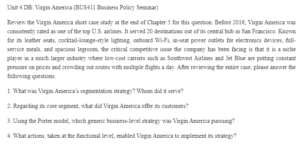Virgin America
What was Virgin America’s segmentation strategy? Whom did it serve?
Virgin America uses a psychographic segmentation strategy. The segmentation variable focuses on customers according to lifestyle, social class, and special characteristic features of consumers. The target market has a specific profile that Virgin America exploits to serve the segment’s needs. Common psychographic characteristics include attitudes, interests, and opinions (Johansson, 2017). The company targets individuals with high tastes, sophisticated lifestyles, and values. Such people engage in exclusive activities, and Virgin America customizes products that serve the segment. The company seeks to satisfy the personality characteristics of people that make rational decisions based on information that Virgin America provides to the consumers. The market segment’s attitude is highly technology-driven and eager to try innovations regardless of the price tag.
Are you interested in obtaining an unedited and original about Virgin America? Our team of experts is ready to assist you.
Regarding its core segment, what did Virgin America offer its customers?
The company serves a tech-savvy segment of customers that can pay for exclusive goods and services. Virgin American provides space trips for clients with the capacity for futuristic consumer products, with flyers accessing complete services. The approach makes the company a provider of premium services in the sector. Virgin America focuses on a small group of loyal clients without competition from major airlines in the country (Bailey, 2020). The company sets and meets realistic prospects and exceeds customers’ expectations.
Virgin American has created a reputation for providing fun, playful, and customer-oriented flight products that include amenities that increase customer experience and embody high efficiency.
Using the Porter model, which generic business-level strategy was Virgin America pursuing?
Virgin America exploits the differentiation strategy to remain unique and maintain the best technological dimensions that attract its small consumers. The company understands that its clients want exclusive services during flights and customize everything to maximize efficiency (Islami, Mustafa, & Topuzovska Latkovikj, 2020). Virgin America has positioned itself as a unique flyer, and customers pay a premium price to access its services. The competitive advantage empowers the firm to meet the upper-class passengers’ needs that demand access to amenities while flying. Customers are assured of reliable services when traveling with the airline because the brand has focused on meeting customers’ needs. Consistency exists in booking speeds, situational awareness, and entertainment while in the air.
What actions, taken at the functional level, enabled Virgin America to implement its strategy?
Virgin America implemented its strategy by exploiting advanced technological solutions that provide a high competitive advantage. The company invested in information technology support systems, advanced engines, and cheaper-cost construction modalities that increased efficiency. Likewise, the firm has invested in customer service to provide seamless and personalized service to passengers. The cabin crew has won awards for providing excellent services. Passengers feel comfortable and praise Virgin America for its reliable services.
Management focuses on the essential needs of customers that increase comfort while traveling, which include entertainment, full-service meals, and spacious legroom.
Similar Posts: https://eminencepapers.com/exemption-of-quality-improvement/
References
Bailey, J. (2020, Sept. 21). How Virgin America was ahead of its time. Simple Flying. Retrieved from https://simpleflying.com/virgin-america-ahead-of-times/
Islami, X., Mustafa, N. & Topuzovska Latkovikj, M. (2020). Linking Porter’s generic strategies to firm performance. Futur Bus J, 6(3). https://doi.org/10.1186/s43093-020-0009-1
Johansson, R. (2017). Which market segmentation variables are most effective in determining new business potential? Arcada. Retrieved from https://www.theseus.fi/bitstream/handle/10024/139967/THESIS%20FINAL%20VERSION.pdf?sequence=1&isAllowed=y
ORDER A PLAGIARISM-FREE PAPER HERE
We’ll write everything from scratch
Question
Week 4 Discussion Forum (MKT6250 Healthcare Marketing)
1. Discuss how marketing changes based on the stages of a product life cycle. Can a product/service overcome the product life cycle? How?

Virgin America
Unit 4 DB: Virgin America (BUS411 Business Policy Seminar)
Review the Virgin America short case study at the end of Chapter 5 for this question. Before 2016, Virgin America was consistently rated as one of the top U.S. airlines. It served 20 destinations out of its central hub in San Francisco. Known for its leather seats, cocktail-lounge-style lighting, onboard Wi-Fi, in-seat power outlets for electronics devices, full-service meals, and spacious legroom, the critical competitive issue the company has been facing is that it is a niche player in a much larger industry where low-cost carriers such as Southwest Airlines and Jet Blue are putting constant pressure on prices and crowding out routes with multiple flights a day. After reviewing the entire case, please answer the following questions.
1. What was Virgin America’s segmentation strategy? Whom did it serve?
2. Regarding its core segment, what did Virgin America offer its customers?
3. Using the Porter model, which generic business-level strategy was Virgin America pursuing?
4. What actions, taken at the functional level, enabled Virgin America to implement its strategy?


